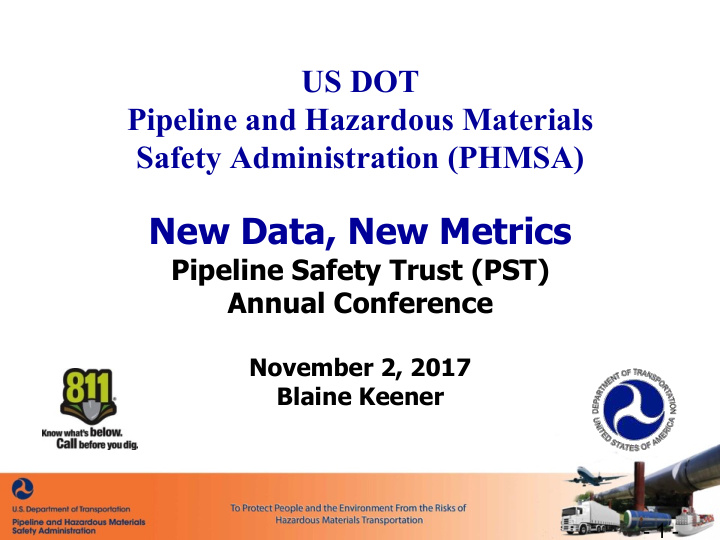



US DOT Pipeline and Hazardous Materials Safety Administration (PHMSA) New Data, New Metrics Pipeline Safety Trust (PST) Annual Conference November 2, 2017 Blaine Keener - 1 -
New PHMSA Data • Underground Natural Gas Storage (UNGS) Facility Incident Reports - collection started in 2017 using the Gas Transmission/Gas Gathering incident report form • UNGS Facility Annual Reports - collection starts in 2018 with reports for calendar year 2017 • Failed attempt to revamp Incident Reports – Revamp project started in 2014 with multiple stakeholders – In July 2017, Office of Management & Budget (OMB) rejected proposed revamp of hazardous liquid accident report – OMB has been considering proposed revamp of three gas incident report forms since April 2017, but has not made a decision - 2 -
New PHMSA Website • PHMSA Home Page https://www.phmsa.dot.gov • Pipeline Data and Statistics https://www.phmsa.dot.gov/data-and-statistics/pipeline/ data-and-statistics-overview – Pipeline Operator Safety Program Data – National Pipeline Performance Measures – State Pipeline Performance Measures – Source Data • Pipeline Forms – current and historical version of reports https://www.phmsa.dot.gov/forms/pipeline-forms - 3 -
National Pipeline Performance Measures • Crude Oil/Refined Petroleum/Biofuel Pipeline Performance Measures • Gas Pipeline Performance Measures • Pipeline Mileage and Facilities • Pipeline Incidents: 20-Year Trends • Incidents Caused by Excavation Damage • Integrity Management (IM) Performance Metrics • Incidents and Leaks Repaired on Federal Land or Outer Continental Shelf (OCS) - 4 -
Gas Distribution Performance Measures published late 2015 Serious Incident per Mile trend & cause pie Significant Incident per Mile 3 trends Leaks per Mile 3 trends & 2 cause pies Excavation Damage 2 trends Cast and Wrought Iron 2 trends Steel Miles – Bare and Unprotected 3 trends Miles by Decade Installed 6 trends - 5 -
Gas Transmission Performance Measures published late 2015 Serious Incident per Mile trend & cause pie Onshore Significant Incident per Mile 3 trends, also HCA and non-HCA trends & cause pies HCA Immediate Repair per Mile trend HCA Leaks & ILI Detectability 2 trends & cause pies Steel Miles – Bare and Unprotected 2 trends Miles by Decade Installed 5 trends Onshore Pipeline Significant Incident Rates per Decade rate chart and cause chart - 6 -
Crude Oil/Refined Petroleum/Biofuel Pipeline Performance Measures published late 2017 Serious Incidents rate per mile and causes Accidents Impacting People or the Environment rate per mile and volume spilled per barrel-mile transported. Displayed for all causes, Integrity Inspection targets, and Operations and Maintenance targets. Miles Inspected by year and inspection method Access to accident report details, by-OpID view, and by-Safety Program view - 7 -
Crude Oil/Refined Petroleum/Biofuel Pipeline Accidents Impacting People or the Environment Rate per Mile Barrels Spilled per Barrel-Mile Transported - 8 -
Crude Oil/Refined Petroleum/Biofuel Pipeline Accidents Impacting People or the Environment Integrity Inspection Targets Rate per Mile Barrels Spilled per Barrel-Mile Transported - 9 -
Crude Oil/Refined Petroleum/Biofuel Pipeline Accidents Impacting People or the Environment Operations and Maintenance Targets Rate per Mile Barrels Spilled per Barrel-Mile Transported - 10 -
Questions? Blaine.Keener@dot.gov 202-366-0970 - 11 -
Recommend
More recommend